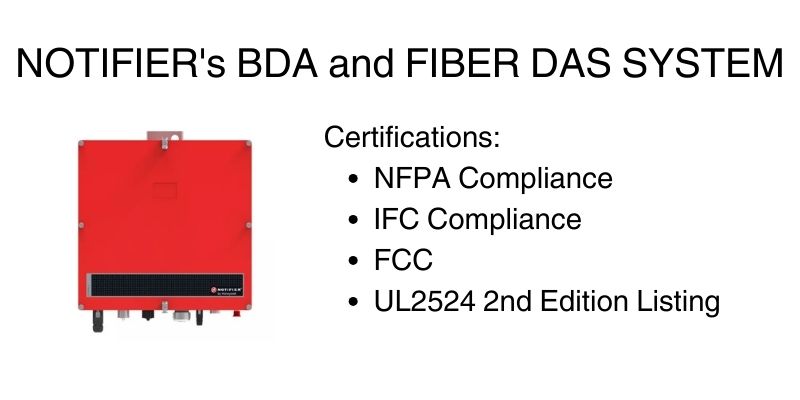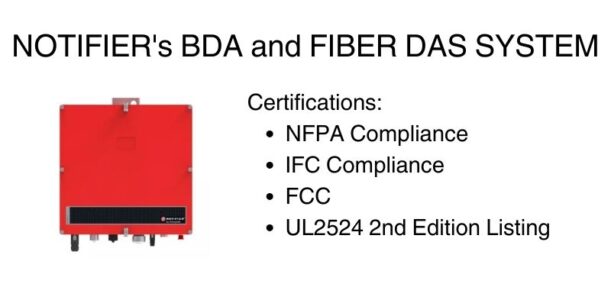
This article was published on 12-12-23 and updated on 1-7-2025
NOTIFIER® BDA (Bi-Directional Amplifier) and Fiber DAS (Distributed Antenna System) systems are critical to ensure communication between first responders during emergencies. Many fire and building safety codes apply to the requirements of Emergency Responder Communication Enhancement Systems (ERCES), and not all systems are created equal.
Working with experienced commercial fire alarm system providers is critical to ensure that your fire and life safety system is designed with UL-listed, ERCES-compliant components such as NOTIFIER® BDA and Fiber DAS.
Emergency Radio Communication Systems
Reliable in-building radio coverage in buildings is essential for first responder communication to coordinate rescue efforts and protect lives during emergencies. However, building materials like concrete, steel, glass, and complex architectural layouts often block or weaken radio signals. This can create dead zones in critical areas such as basements, stairwells, and elevators, where clear communication is most needed.
According to a 2017 study published by the International Association of Fire Chiefs (IAFC) and the Safer Building Coalition, 94% of first responders surveyed relayed that:
- 56% of first responders experienced in-building communication failures during emergencies within the previous two years.
- 5% of first responders encountered dead spots inside buildings caused by poor radio frequency coverage.
Inadequate communication during emergencies poses serious risks. Without reliable signal coverage, first responders may struggle to receive or relay critical information, delaying rescue operations and increasing the danger to building occupants. Reliable in-building communication is essential for emergency response and is required in fire and life safety codes.
BDA and Fiber DAS technologies amplify and distribute enhanced communication for first responders’ signals throughout a building, ensuring seamless two-way radio communication even for those typically prone to signal loss.
The Importance of Emergency Communication Systems
As a direct result of the tragedies occurring on 9/11/01 at the World Trade Centers, the National Institute of Standards and Technology (NIST) published recommendations to improve public safety, including national fire code updates to ensure reliable radio coverage in buildings. The horrific Hawaii fires in May of 2024 caused fire departments across the state to reevaluate their emergency communication systems when efforts by first responders were complicated due to a lack of advanced communication tools in fire vehicles.
Components designed to boost signal to maintain effective fire alarm communication systems in emergency situations include:
- Bi-Directional Amplifiers (BDA) – A BDA mainly amplifies signals for first responders’ radios. A BDA system generally consists of rooftop antennas and amplifiers and can be effective in smaller buildings.
- Fiber Distributed Antenna Systems (Fiber DAS) – a Fiber DAS requires a more complex installation with fiber optic cables, distributed antennas, and amplifiers and can handle various cellular carrier signals. Fiber DAS systems are better suited for large, complex structures with diverse signal needs.
Emergency Responder Communication Enhancement Systems (ERCES) Key Codes and Standards
Ensuring compliance with Emergency Responder Communication Enhancement Systems (ERCES) requires adherence to several critical codes and standards. These regulations establish the performance, reliability, and installation requirements necessary to support first responders during emergencies. Key codes and standards include:
NFPA 1: Fire Code
- NFPA 1 outlines the general provisions for fire safety, including requirements for in-building communications for first responders.
- It mandates the implementation of ERCES, where signal coverage inside a building is inadequate to support emergency responder communications.
NFPA 72: National Fire Alarm and Signaling Code
- NFPA 72 sets the standard for fire alarm and signaling systems, including provisions for emergency communication systems such as ERCES.
- It ensures that ERCES installations meet performance standards for reliable communication during emergencies.
NFPA 1221: Standard for Emergency Services Communications
- This standard specifies installing and maintaining emergency services communication systems, including ERCES.
- It includes guidance on signal strength, coverage testing, and system survivability.
- The IFC requires buildings to meet specific criteria for in-building emergency responder communications.
- Key provisions include minimum inbound and outbound signal strength, coverage area requirements, and equipment survivability during emergencies.
International Building Code (IBC)
- The IBC provides structural and fire safety requirements for buildings, including ERCES as a condition for occupancy where necessary.
- It aligns with the IFC to ensure comprehensive building safety.
National Electrical Code (NEC)
- The NEC addresses electrical requirements for ERCES installations, including power backup and cable protection, to ensure system reliability during emergencies.
Key Requirements Across Codes
The provisions across these codes and standards emphasize common requirements for BDA (Bi-Directional Amplifier) and Fiber DAS (Distributed Antenna Systems), including:
- Signal Strength and Coverage: ERCES must provide adequate inbound and outbound signal strength, covering at least 90% of each floor in general areas and 99% in critical areas like stairwells and fire command centers.
- Reliability Standards: Systems must include power backup, water protection, and fire-rated enclosures to ensure functionality during emergencies.
- Frequency Bands: Systems must support specified public safety frequency bands for fire, law enforcement, and EMS communications.
- Testing and Maintenance: Regular testing and ongoing monitoring are required to maintain system effectiveness, with failure to comply potentially resulting in penalties.
- Local Ordinances: Jurisdictions may impose additional requirements or offer waivers depending on unique local needs.
Why ERCES Compliance Matters
Meeting these code requirements is not just a regulatory necessity but a critical step toward ensuring the safety of building occupants and emergency responders. Choosing ERCES solutions like NOTIFIER®’s UL 2524-certified BDAS and Fiber DAS systems guarantees compliance with these stringent standards while delivering reliable, high-performance communication during emergencies.
Learn more about UL 2524 compliance and When an In-Building Emergency Responder Communication Enhancement System is Needed. Contact HRSS/SMG for code-compliant commercial fire alarm design, installation, maintenance, and support.
Components of a NOTIFIER® BDA System
NOTIFIER®’s Bi-Directional Amplifier (BDA) systems include several essential components working together to ensure reliable and consistent in-building communication for emergency responders. These components are designed to meet stringent performance and compliance standards, eliminating dead zones and maintaining signal integrity during critical moments.
- RF Amplifier Control Cabinet
The control cabinet houses the system’s amplifier and ensures reliable operation. It includes:- Battery Backup: Maintains system functionality during power outages.
- FCC-Approved Frequency Tuning: Configured to operate on specific public safety frequencies required by local jurisdictions.
- Distributed Antennas
Strategically placed throughout the building, these antennas ensure complete signal coverage. They eliminate dead zones in critical areas such as stairwells, basements, and elevator shafts, ensuring uninterrupted communication. - Exterior Donor Antenna
Positioned on the building’s exterior, this antenna connects the internal BDA system to external networks, such as fire trucks, dispatch centers, or emergency control stations. It facilitates seamless communication between the building and external responders. - Cabling and Connectors
High-quality coaxial cables and connectors link the system components, preserving signal strength and integrity. Proper installation of these components is crucial for ensuring system reliability.
High-Rise Security Systems is a premier NOTIFIER fire alarm distributor, offering NOTIFIER® BDA and Fiber DAS systems and complete fire alarm system solutions.
Components of a NOTIFIER® Fiber DAS System
The Fiber Distributed Antenna System (DAS) from NOTIFIER® provides comprehensive signal distribution throughout a building, using a network of fiber-optic cables and antennas to ensure seamless communication. Speak to a reputable NOTIFIER® distributor to learn how you can enhance the safety and security of your building.
Here are the key components of a Fiber DAS system:
- Head-End Equipment
This central unit manages the signals entering and leaving the system. It includes:- Master Unit: Processes and distributes signals from the donor antenna to the fiber network.
- Power Supply: Ensures consistent operation, even during power interruptions.
- Fiber Optic Cables
These cables serve as the backbone of the Fiber DAS, transmitting signals with minimal loss over long distances. They connect the head-end equipment to remote units and antennas, ensuring reliable distribution across the building. - Remote Units
These devices receive the signals from the head-end equipment and amplify them for distribution. Remote units are strategically placed to maintain coverage in larger buildings or across multiple floors. - Distributed Antennas
Similar to the BDA system, antennas in the Fiber DAS are positioned throughout the building to provide full coverage, even in hard-to-reach areas. - Exterior Donor Antenna
This antenna connects the Fiber DAS system to external networks, enabling communication with fire trucks, emergency dispatch, and other public safety agencies.
Both NOTIFIER® BDA and Fiber DAS systems are customized during commercial fire alarm design to meet the needs of complex building layouts and stringent safety standards.
HRSS/SMG specializes in commercial fire alarm design, providing custom solutions to ensure safety and compliance for businesses. As a trusted NOTIFIER® alarm distributor, we deliver advanced fire alarm and communication systems backed by industry-leading expertise. Contact us today to discuss how we can enhance your fire safety systems with NOTIFIER® BDA and Fiber DAS systems.



